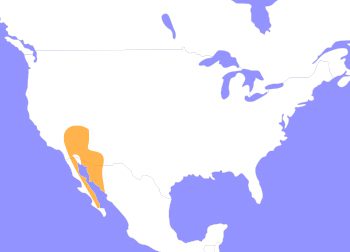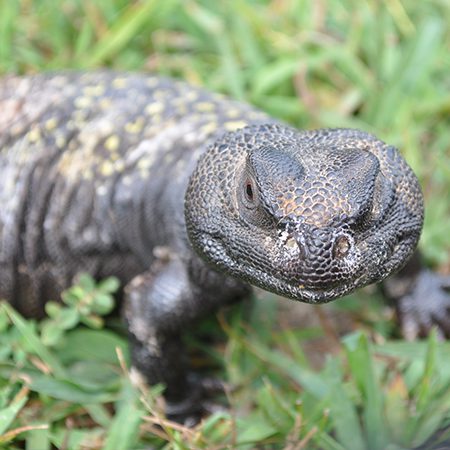Chuckwalla
Sauromalus ater
Chuckwallas are found in the southwestern region of the United States, Mexico, and at least 30 islands in the Gulf of Mexico. They thrive in the Mojave and Sonoran deserts. They prefer places with places to hide, like under rocks or in crevices, and with plenty of vegetation for them to munch on. They have rough skin that can vary from brown to orange to dark yellow, depending on the specific habitat they live in. Juveniles and females tend to be lighter (in color and weight). They have loose skin on their sides. When threatened, a chuckwalla will hide and puff up to wedge itself into that spot. This prevents predators from being able to pull them out. Their tails are almost half their length, which averages at about half a foot. They weigh around 0.5-0.75 lbs. They can live up to 30 years in the wild, but the average lifespan is only 15 years because mortality is high for juveniles. In captivity, the oldest chuckwalla was recorded to be 65 years old.
Male chuckwallas will maintain territories with several females living within it. They are solitary outside of mating season. In the winter, they may go through brumation (almost hibernation but not fully dormant) if temperatures get too low. In the summer, they may estivate, which is the heat form of hibernation. In order to stay cool they lower their activity levels.

Chuckwallas are found primarily in regions of the southwestern United States and northern Mexico.
HABITAT -They prefer arid climates of the Mojave and Sonoran desert.
DIET -They are herbivorous, eating leaves and fruit; occasionally, insects are eaten.
FUN FACT -Chuckwallas have skin that looks like granite which helps them stay camouflaged against rocks in the wild.
SOCIAL BEHAVIOR -They are solitary outside of mating season and very docile to humans.
ACTIVITY -They are diurnal, though may hide during the hottest parts of the day.
PREDATORS -Predators include red-tailed hawks, American kestrels, coyotes, and Mojave rattlesnakes.
SIZE -They weigh 0.5-0.75 lb and can be 3-8 in long.
RELATIVES -Their closest relatives are iguanas.
CONSERVATION -They have been classified as LC (Least Concern) by the IUCN.
Cub Creek Animal Care Information
Housing - Our Chuckwallas are housed in the Reptile Room, where the rest of our lizards and snakes are also kept. They live in large heat and UV light-controlled enclosures. Fresh water and plenty of places to hide, explore, and bask are provided for them.
Diet - Our lizards are fed on a reptile specific schedule, meaning they are fed Monday, Tuesday, Thursday, and Saturday. Reptiles have slow metabolisms and do not require to be fed everyday if they are fed adequately. They are given apple, shredded sweet potato, and chopped greens supplemented with a calcium powder in order to give them all the necessary nutrients they need to be healthy.
Enrichment - Most of the enrichment we give our lizards comes from handling and socializing them and being in a multispecies enclosure. In the summer, they get held daily and sometimes even brought outside when it is warmer. During the offseason, Animal Interns can be found carrying them around on their shoulders as they work!

